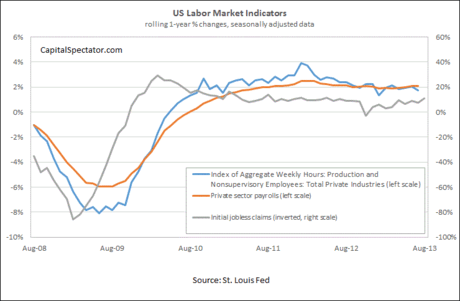It’s Labor Day in the US, which means that the financial markets are closed and employment activity is at a minimum on the first Monday of September. The lull is the perfect excuse to briefly review where we stand on several key indicators for the labor force before retiring for the rest of the day with some R&R.
Private payrolls continue to grow at 2.0% a year. Not great, but not awful. The fact that the economy has been consistently minting new jobs on a net basis is encouraging for thinking that the expansion will roll on. Meantime, the index of weekly hours worked for production/nonsupervisory employees continues to grow on a year-over-year basis, although this indicator slipped a bit in the July update with a 1.7% rise vs. a year ago, or down from a 2.0% gain in June. Not a good sign… if the deceleration continues. On a brighter note, new jobless claims continue to slide. Based on monthly data, the average for the August figures published so far are lower by nearly 11% vs. a year ago (these changes are inverted on the chart below for easier comparison with payrolls and the index of hours worked). As a leading indicator, the ongoing decline in new filings for unemployment benefits offers the strongest case for optimism in the realm of the broad labor trend.

Overall, it’s fair to say that the labor market continues to heal, albeit moderately. Can we expect more of the same in this Friday’s August update on payrolls from the government? Yes, according to the consensus forecast. Private payrolls are expected to deliver a slightly better round of growth, adding a net 180,000 for August, according to Briefing.com. That’s a touch better than the 161,000 gain in July. Not great, but not awful.